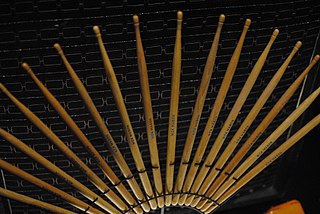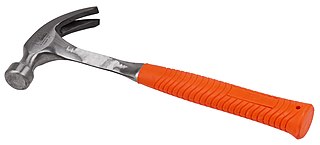 W
WA control knob is a rotary device used to provide manual input adjustments to a mechanical/electrical system when grasped and turned by a human operator, so that differing extent of knob rotation corresponds to different desired input. Control knobs are a simpler type of input hardware and one of the most common components in control systems, and are found on all sorts of devices from taps and gas stoves to optical microscopes, potentiometers and radio tuners.
 W
WA drumstick is a type of percussion mallet used particularly for playing snare drum, drum kit, and some other percussion instruments, and particularly for playing unpitched percussion.
 W
WElectric vehicle warning sounds are sounds designed to alert pedestrians to the presence of electric drive vehicles such as hybrid electric vehicles (HEVs), plug-in hybrid electric vehicles (PHEVs), and all-electric vehicles (EVs) travelling at low speeds. Warning sound devices were deemed necessary by some government regulators because vehicles operating in all-electric mode produce less noise than traditional combustion engine vehicles and can make it more difficult for pedestrians and cyclists to be aware of their presence. Warning sounds may be driver triggered or automatic at low speeds; in type, they vary from clearly artificial to those that mimic engine sounds and those of tires moving over gravel.
 W
WIn percussion, grip refers to the manner in which the player holds the percussion mallet or mallets, whether drum sticks or other mallets.
 W
WA handle is a part of, or attachment to, an object that allows it to be grasped and manipulated by hand. The design of each type of handle involves substantial ergonomic issues, even where these are dealt with intuitively or by following tradition. Handles for tools are an important part of their function, enabling the user to exploit the tools to maximum effect. Package handles allow for convenient carrying of packages.
 W
WA key is a specific part of a musical instrument. The purpose and function of the part in question depend on the instrument.
 W
WA musical keyboard is the set of adjacent depressible levers or keys on a musical instrument. Keyboards typically contain keys for playing the twelve notes of the Western musical scale, with a combination of larger, longer keys and smaller, shorter keys that repeats at the interval of an octave. Depressing a key on the keyboard makes the instrument produce sounds—either by mechanically striking a string or tine, plucking a string (harpsichord), causing air to flow through a pipe organ, striking a bell (carillon), or, on electric and electronic keyboards, completing a circuit. Since the most commonly encountered keyboard instrument is the piano, the keyboard layout is often referred to as the piano keyboard.
 W
WA pedalboard is a keyboard played with the feet that is usually used to produce the low-pitched bass line of a piece of music. A pedalboard has long, narrow lever-style keys laid out in the same semitone scalar pattern as a manual keyboard, with longer keys for C, D, E, F, G, A and B, and shorter, higher keys for C♯, D♯, F♯, G♯ and A♯. Training in pedal technique is part of standard organ pedagogy in church music and art music.
 W
WOn a firearm or other tools, a pistol grip is a distinctly protruded handle underneath the main mechanism, to be held by the user's hand at a more vertical angle, similar to the how one would hold a conventional pistol.
 W
WA push-button or simply button is a simple switch mechanism to control some aspect of a machine or a process. Buttons are typically made out of hard material, usually plastic or metal. The surface is usually flat or shaped to accommodate the human finger or hand, so as to be easily depressed or pushed. Buttons are most often biased switches, although many un-biased buttons still require a spring to return to their un-pushed state. Terms for the "pushing" of a button include pressing, depressing, mashing, slapping, hitting, and punching.
 W
WIn electronics, a remote control or clicker is an electronic device used to operate another device from a distance, usually wirelessly. In consumer electronics, a remote control can be used to operate devices such as a television set, DVD player or other home appliance. A remote control can allow operation of devices that are out of convenient reach for direct operation of controls. They function best when used from a short distance. This is primarily a convenience feature for the user. In some cases, remote controls allow a person to operate a device that they otherwise would not be able to reach, as when a garage door opener is triggered from outside.
 W
WA steering wheel is a type of steering control in vehicles.
 W
WA telegraph key is a specialized electrical switch used by a trained operator to transmit text messages in Morse code in a telegraphy system. Keys are used in all forms of electrical telegraph systems, such as landline or "wire" electrical telegraphy, and "wireless", or radio telegraphy. An operator operates the switch, connecting and disconnecting the electrical circuit, creating electrical pulses of two different lengths called "dits" and "dahs" to spell out text messages in code.
 W
WTRUE DC is a type of Switch Disconnect (Isolator) used in Solar Photovoltaic installations, in accordance with EN 60364-7-712. Pioneered by UK based IMO Precision Controls Ltd, and later adopted by other manufacturers such as Santon and ABB, the isolator design incorporates a user independent switching action so as the handle is moved, it interacts with a spring mechanism which, upon reaching a set point, causes the contacts to "SNAP" over, thereby ensuring a very fast break/make action. This mechanism means that the disconnection of the load circuits and the suppression of the electrical arc, produced by a constant DC load, is normally extinguished in a maximum of 5 ms using the specific pole suppression chambers incorporated into the design.
 W
WIn the industrial design field of human-computer interaction, a user interface (UI) is the space where interactions between humans and machines occur. The goal of this interaction is to allow effective operation and control of the machine from the human end, whilst the machine simultaneously feeds back information that aids the operators' decision-making process. Examples of this broad concept of user interfaces include the interactive aspects of computer operating systems, hand tools, heavy machinery operator controls, and process controls. The design considerations applicable when creating user interfaces are related to, or involve such disciplines as, ergonomics and psychology.